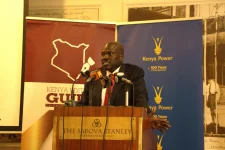Great news for Kenyans! According to Kenya Power, electricity costs have been going down over the past year. This is thanks to the Kenyan Shilling getting stronger against the US Dollar.
Joseph Siror, the Managing Director and CEO of Kenya Power explains that as the shilling strengthens, it lowers customers' pass-through costs. These costs include foreign exchange rates and fuel prices, which are heavily influenced by the current dollar exchange rate.
In addition to the stronger shilling, the base energy cost has also gone down since the electricity tariff was reviewed in April 2023. The new three-year tariff plan means lower costs per unit, starting each July for the next three years.
Siror says the base tariff has dropped from Sh19.04 per unit in 2023 to Sh17.94 now. He shared this information during a meeting with the Kenya Editors Guild on Tuesday.
However, Kenya Power is worried that a push to include way-leave charges on power infrastructure could undo this progress. If this happens, electricity costs could go up by as much as 30%, and customers would have to cover this increase through pass-through charges.
Kenya Power has a massive network of power lines spanning over 319,000 kilometers across all 47 counties. Siror explains that charging way leaves on these lines at a rate of Sh200 per meter would add up to Sh63.8 billion per year.
To put that in perspective, it's about 30% of the entire energy sector's revenue requirements. That extra cost would have to be recovered through monthly electricity bills.
Siror warns that if this happens, electricity will become unaffordable for most Kenyans. He also points out that Section 223 of the Energy Act 2019 doesn't allow public entities to charge levies on public energy infrastructure without regulatory approval.
Joseph Siror, the Managing Director and CEO of Kenya Power explains that as the shilling strengthens, it lowers customers' pass-through costs. These costs include foreign exchange rates and fuel prices, which are heavily influenced by the current dollar exchange rate.
In addition to the stronger shilling, the base energy cost has also gone down since the electricity tariff was reviewed in April 2023. The new three-year tariff plan means lower costs per unit, starting each July for the next three years.
Siror says the base tariff has dropped from Sh19.04 per unit in 2023 to Sh17.94 now. He shared this information during a meeting with the Kenya Editors Guild on Tuesday.
However, Kenya Power is worried that a push to include way-leave charges on power infrastructure could undo this progress. If this happens, electricity costs could go up by as much as 30%, and customers would have to cover this increase through pass-through charges.
Kenya Power has a massive network of power lines spanning over 319,000 kilometers across all 47 counties. Siror explains that charging way leaves on these lines at a rate of Sh200 per meter would add up to Sh63.8 billion per year.
To put that in perspective, it's about 30% of the entire energy sector's revenue requirements. That extra cost would have to be recovered through monthly electricity bills.
Siror warns that if this happens, electricity will become unaffordable for most Kenyans. He also points out that Section 223 of the Energy Act 2019 doesn't allow public entities to charge levies on public energy infrastructure without regulatory approval.












